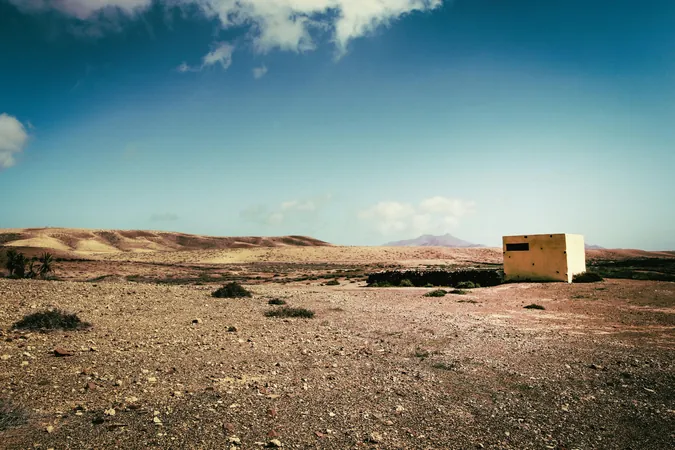
The Hidden Threat of Acid Sulfate Soils: Why We Should Be Worried!
2024-11-05
Author: Rajesh
Introduction
Acid sulfate soils, often referred to as 'the nastiest soils on Earth,' are gaining increasing recognition for their devastating effects on ecosystems. These unique soils, notorious for their orange color, not only jeopardize vegetation but also pose a lethal risk to aquatic life. Recent research led by Anders Johnson along Sweden's expansive coastline highlights the alarming prevalence of acid sulfate soils and their critical impact on both water quality and biodiversity.
Formation and Risks of Acid Sulfate Soils
As human activities continue to exacerbate the formation of these harmful soils, scientists emphasize the need to delve deeper into the geochemical and microbiological processes at play to develop effective mitigation strategies. A groundbreaking doctoral thesis sheds light on the microbiology of these soils, revealing their detrimental impacts on the environment.
Chemical Reactions and Environmental Impact
The danger of acid sulfate soils arises when sulfide-rich sediments—commonly found in coastal areas—are exposed to oxygen. This exposure, caused by both natural phenomena and human interference, ignites a series of chemical reactions, driven by microbial communities, that significantly lower soil pH and release toxic acids and heavy metals into adjacent ecosystems.
Consequences for Aquatic Life
During rain or snowmelt events, the accumulated acids and dissolved metals can wash into local water bodies, leading to potentially catastrophic fish kills and loss of plant life. 'Aluminum emerges as a particularly harmful metal released from these soils, as its high concentrations in waterways can suffocate fish by binding to their gills, severely impairing their ability to obtain oxygen,' warns Johnson, a researcher and Doctor in Ecology from Linnaeus University.
Recent Incidents and Research Findings
Recent alarming instances, including a notable fish kill in northern Sweden directly linked to these soils, underscore the urgent need for awareness. In Kalmar, mysterious fish deaths have also been associated with acid sulfate soils, suggesting a widespread problem that could escalate if left unaddressed.
Geographical Significance of Acid Sulfate Soils
Johnson’s extensive dissertation, which encompasses research along Sweden's 2000-kilometer coastline, reveals that Sweden and Finland harbor the world's highest concentrations of boreal acid sulfate soils. A 2002 Finnish report indicated that these soils are responsible for greater acid and metals release into the ecosystem than all industrial activities combined in the country. The full extent of these soils in Sweden remains largely unknown, but Johnson's findings provide essential data to understand their implications.
Expansion of Known Areas
While researchers had previously pinpointed significant areas of acid sulfate soils in northern Sweden, this new research expands the known regions into southern Sweden too. 'Although the scale of these soils tends to be smaller in southern Sweden, they exhibit a propensity to become more toxic, releasing increased amounts of acid and metals into the surrounding environments,' Johnson explains.
Future Projections and Climate Change
The problem is projected to worsen as climate change triggers more frequent droughts and wetland drainage, primarily for agricultural purposes. 'Acid sulfate soils will continue to become a pressing issue as these environmental changes escalate,' Johnson notes.
Mitigation Strategies
So, what can be done? The research team at Linnaeus University is probing into the intricate geochemical and microbiological dynamics involved in the formation of acid sulfate soils, seeking innovative methods to mitigate their negative impacts. Current strategies, such as treating soils with limestone to counteract acidification or re-submerging the areas, are often expensive and ineffective.
Prevention is Key
To combat the crisis effectively, experts believe it's crucial to prevent these soils from becoming oxidized in the first place. 'Once the process has started, reversing it becomes a daunting challenge. Identifying the specific locations of these soils is essential to avoid unnecessary disruption,' emphasizes Johnson.
Conclusion and Call to Action
Furthermore, if they are disturbed, gaining insights into the complex interactions between geochemistry and microbiology offers a lifeline for developing targeted solutions to reduce these soils' harmful effects. As climate change and human interventions continue to alter landscapes, understanding and addressing the hazards posed by acid sulfate soils has never been more critical. The time to act is now—let's not wait until it's too late!


 Brasil (PT)
Brasil (PT)
 Canada (EN)
Canada (EN)
 Chile (ES)
Chile (ES)
 España (ES)
España (ES)
 France (FR)
France (FR)
 Hong Kong (EN)
Hong Kong (EN)
 Italia (IT)
Italia (IT)
 日本 (JA)
日本 (JA)
 Magyarország (HU)
Magyarország (HU)
 Norge (NO)
Norge (NO)
 Polska (PL)
Polska (PL)
 Schweiz (DE)
Schweiz (DE)
 Singapore (EN)
Singapore (EN)
 Sverige (SV)
Sverige (SV)
 Suomi (FI)
Suomi (FI)
 Türkiye (TR)
Türkiye (TR)